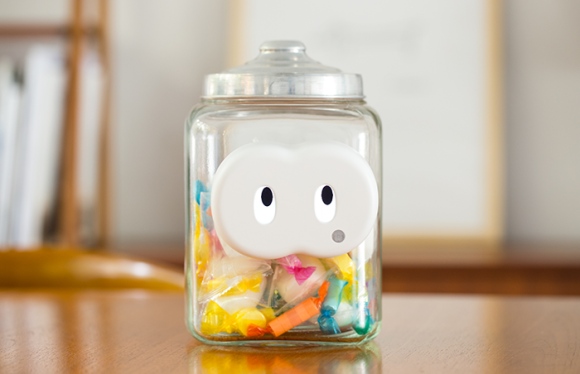
Some of you may remember Neurowear as the company who made Necomimi, the robotic cat ears that you can control with brainwaves, and their follow up projects Shippo (mind controlled robot tail) and Mico (mind controlled music player).
This time, however, Neurowear won’t be reading our brain waves but will instead try to give some to your fridge or sofa. The latest project called Mononome works with your smartphone to deepen your relationship with a household item of your choice by adding a touch of humanity to it.
Mononome is currently on display for Tokyo Designers Week from 25 October to 3 November. We caught up with Neurowear’s Kana Nakano during the exhibition to learn more about it.
Mononome is a device shaped like a pair eyes and has an adhesive back which allows it to be attached to a cupboard, vacuum cleaner or whatever you’d like. It comes equipped with vibration sensors that records when and how often the object is used in coordination with your smartphone. If you are using it too roughly, frequently, or infrequently it will react by showing emotion or a message in its LED eyes. Here’s Ms. Nakano to tell us more.
Ms. Nakano please tell us more about the Mononome in the exhibit.
“Here is a Mononome attached to a candy jar. If you take some candy two times in a row then it will say “NO.” And the Mononome on this chair will have a lonely expression if no one sits in it in a while. Over time these items will come to have their own existence like family or friends.”
Why do we want these things to become like friends?
“Take a diet app for example. More than coldly telling you to “input your weight” it should make people want to get on the scale who usually dread it. In interacting with humans it is important for a device to have intelligence, but we think having warmth and intimacy are also important. For this you need to have a certain cuteness.”
And so you came up with this design?
“We thought that part of the fun of the eye shape is wondering what thing you’re going to attach it to.”
Tell me the reason you made Mononome.
“We thought it would be good to have things understand the feelings of people. Ideally it would be like the banquet scene from Beauty and the Beast with pots dancing around and items offering their hospitality.”
What would you attach a Mononome to?
“Like in the video we put out, I’d want to try it on a vacuum cleaner or refrigerator. Other than that I think it would be useful for women to use on their sanitary pad cases. The Mononomes at this exhibition are prototypes. We hope the final version will be much smaller so it can be attached to a wider range of things like that.”
Thank you for speaking with us today.
As Ms. Nakano said, these Mononomes are only prototypes, so a full list of what they will do on release has not been completed yet. However, Mononome perhaps should be seen more as a concept of the importance of humanity in technology design rather than simply a product itself. It’s a factor that other designers in the field could benefit from adding to any product.
Source: Mononome, Tokyo Design Week (Japanese)
Top Image: Mononome
Interview and other photos by Toru Imamura
▼ A video demonstration we took at the exhibit
▼ A slightly slicker presentation from Neurowear
▼ And for old times’ sake, here’s Necomimi again
[ Read in Japanese ]

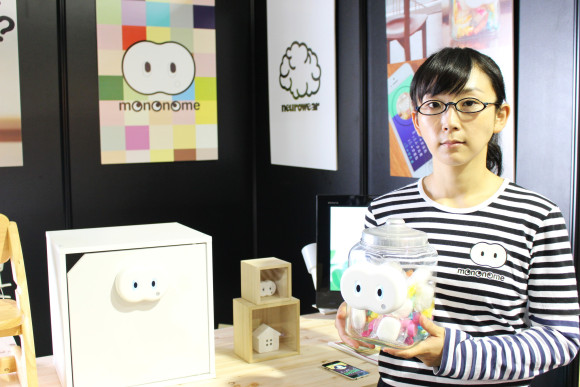
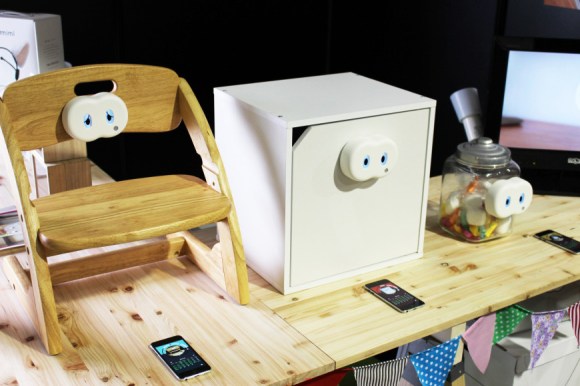
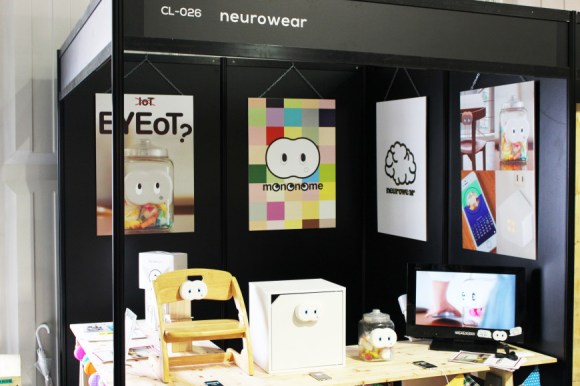
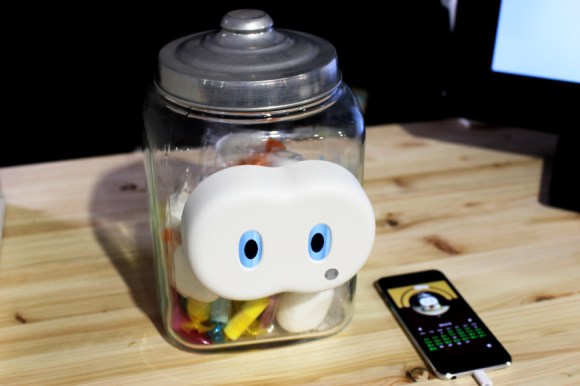
 Future Alert: In 2015 you’ll be able to use your smartphone to brush your teeth, kind of
Future Alert: In 2015 you’ll be able to use your smartphone to brush your teeth, kind of Premium Cocorobo will clean your floor, wake you up, and probably creep out your friends
Premium Cocorobo will clean your floor, wake you up, and probably creep out your friends I scream, you scream, we all scream at “Soft Susheam”
I scream, you scream, we all scream at “Soft Susheam” Eat not like a king, but like a cat at this cat food-themed restaurant in Japan
Eat not like a king, but like a cat at this cat food-themed restaurant in Japan Thomas the Tank Engine toy trolls Twitterer, terrorizes vacuum
Thomas the Tank Engine toy trolls Twitterer, terrorizes vacuum McDonald’s new Happy Meals offer up cute and practical Sanrio lifestyle goods
McDonald’s new Happy Meals offer up cute and practical Sanrio lifestyle goods All-you-can-drink Starbucks and amazing views part of Tokyo’s new 170 meter-high sky lounge
All-you-can-drink Starbucks and amazing views part of Tokyo’s new 170 meter-high sky lounge Super Nintendo World expansion gets delayed for several months at Universal Studios Japan
Super Nintendo World expansion gets delayed for several months at Universal Studios Japan Studio Ghibli glasses cases let anime characters keep an eye on your spectacles
Studio Ghibli glasses cases let anime characters keep an eye on your spectacles Kyoto’s 100 Demons yokai monster parade returns!
Kyoto’s 100 Demons yokai monster parade returns! More foreign tourists than ever before in history visited Japan last month
More foreign tourists than ever before in history visited Japan last month Disney princesses get official manga makeovers for Manga Princess Cafe opening in Tokyo
Disney princesses get official manga makeovers for Manga Princess Cafe opening in Tokyo Godzilla figure based on Shin Godzilla CG model is stunningly detailed, shockingly expensive
Godzilla figure based on Shin Godzilla CG model is stunningly detailed, shockingly expensive Hamster abandoned at Tokyo ramen restaurant gets new home
Hamster abandoned at Tokyo ramen restaurant gets new home Fan art of new Digimon cast in old style sparks debate on what qualifies as “f***ing disgusting”
Fan art of new Digimon cast in old style sparks debate on what qualifies as “f***ing disgusting” Starbucks reopens at Shibuya Scramble Crossing with new look and design concept
Starbucks reopens at Shibuya Scramble Crossing with new look and design concept Beautiful new Final Fantasy T-shirt collection on the way from Uniqlo【Photos】
Beautiful new Final Fantasy T-shirt collection on the way from Uniqlo【Photos】 Is the new Shinkansen Train Desk ticket worth it?
Is the new Shinkansen Train Desk ticket worth it? Foreign English teachers in Japan pick their favorite Japanese-language phrases【Survey】
Foreign English teachers in Japan pick their favorite Japanese-language phrases【Survey】 Japanese convenience store packs a whole bento into an onigiri rice ball
Japanese convenience store packs a whole bento into an onigiri rice ball We try out “Chan Ramen”, an underground type of ramen popular in the ramen community
We try out “Chan Ramen”, an underground type of ramen popular in the ramen community Studio Ghibli releases Kiki’s Delivery Service chocolate cake pouches in Japan
Studio Ghibli releases Kiki’s Delivery Service chocolate cake pouches in Japan Japan’s bone-breaking and record-breaking roller coaster is permanently shutting down
Japan’s bone-breaking and record-breaking roller coaster is permanently shutting down New definition of “Japanese whiskey” goes into effect to prevent fakes from fooling overseas buyers
New definition of “Japanese whiskey” goes into effect to prevent fakes from fooling overseas buyers Our Japanese reporter visits Costco in the U.S., finds super American and very Japanese things
Our Japanese reporter visits Costco in the U.S., finds super American and very Japanese things Studio Ghibli unveils Mother’s Day gift set that captures the love in My Neighbour Totoro
Studio Ghibli unveils Mother’s Day gift set that captures the love in My Neighbour Totoro Foreign passenger shoves conductor on one of the last full runs for Japan’s Thunderbird train
Foreign passenger shoves conductor on one of the last full runs for Japan’s Thunderbird train Domino’s Japan now sells…pizza ears?
Domino’s Japan now sells…pizza ears? New Japanese KitKat flavour stars Sanrio characters, including Hello Kitty
New Japanese KitKat flavour stars Sanrio characters, including Hello Kitty Kyoto creates new for-tourist buses to address overtourism with higher prices, faster rides
Kyoto creates new for-tourist buses to address overtourism with higher prices, faster rides Sales of Japan’s most convenient train ticket/shopping payment cards suspended indefinitely
Sales of Japan’s most convenient train ticket/shopping payment cards suspended indefinitely Sold-out Studio Ghibli desktop humidifiers are back so Totoro can help you through the dry season
Sold-out Studio Ghibli desktop humidifiers are back so Totoro can help you through the dry season Japanese government to make first change to romanization spelling rules since the 1950s
Japanese government to make first change to romanization spelling rules since the 1950s Ghibli founders Toshio Suzuki and Hayao Miyazaki contribute to Japanese whisky Totoro label design
Ghibli founders Toshio Suzuki and Hayao Miyazaki contribute to Japanese whisky Totoro label design Doraemon found buried at sea as scene from 1993 anime becomes real life【Photos】
Doraemon found buried at sea as scene from 1993 anime becomes real life【Photos】 Tokyo’s most famous Starbucks is closed
Tokyo’s most famous Starbucks is closed One Piece characters’ nationalities revealed, but fans have mixed opinions
One Piece characters’ nationalities revealed, but fans have mixed opinions We asked a Uniqlo employee what four things we should buy and their suggestions didn’t disappoint
We asked a Uniqlo employee what four things we should buy and their suggestions didn’t disappoint Princesses, fruits, and blacksmiths: Study reveals the 30 most unusual family names in Japan
Princesses, fruits, and blacksmiths: Study reveals the 30 most unusual family names in Japan Cat terrified of vacuum cleaner chooses the strangest place to hide
Cat terrified of vacuum cleaner chooses the strangest place to hide Tokyo’s Nakano to be transformed into cosplay heaven this Halloween for MAG Festa 2015
Tokyo’s Nakano to be transformed into cosplay heaven this Halloween for MAG Festa 2015 Does how you dress affect what a sushi restaurant serves you? We experiment in Ginza
Does how you dress affect what a sushi restaurant serves you? We experiment in Ginza Love oysters? You can now wear them in style — as a shoulder bag!
Love oysters? You can now wear them in style — as a shoulder bag! A deep conversation about women and fetishism! Monthly publication talk event for “Underwater Knee-High Girls” to be held
A deep conversation about women and fetishism! Monthly publication talk event for “Underwater Knee-High Girls” to be held Why squash bugs when you can trap them in this cool vacuum gun?
Why squash bugs when you can trap them in this cool vacuum gun? Funasshi’s unofficial mascot Satosshi grabs a pear burger and risks getting beaten up
Funasshi’s unofficial mascot Satosshi grabs a pear burger and risks getting beaten up SoftBank prohibits intercourse with its robot Pepper
SoftBank prohibits intercourse with its robot Pepper Outdoor brand Logos teams up with Aichi sake brewery to make your camping more boozy
Outdoor brand Logos teams up with Aichi sake brewery to make your camping more boozy More fun and delicious treats make it to the Ghibli-themed menu of Tokyo art exhibit’s cafe
More fun and delicious treats make it to the Ghibli-themed menu of Tokyo art exhibit’s cafe Giant pilotable robot appears at Japan Mobility Show, stirs our mecha-loving souls【Pics, vids】
Giant pilotable robot appears at Japan Mobility Show, stirs our mecha-loving souls【Pics, vids】 Village Vanguard releases adorable cat motif gaming earphones!
Village Vanguard releases adorable cat motif gaming earphones! Anime fans vote with their pervy wallets, crowdfund gigantic strap-on penguin boners
Anime fans vote with their pervy wallets, crowdfund gigantic strap-on penguin boners Twitter has “cute competition,” this hamster is winning with amazing vacuum cleaner impression
Twitter has “cute competition,” this hamster is winning with amazing vacuum cleaner impression Is boob-shaped controller a clever gag ad, pie in the sky dream, or the future of gaming? 【Video】
Is boob-shaped controller a clever gag ad, pie in the sky dream, or the future of gaming? 【Video】
Leave a Reply